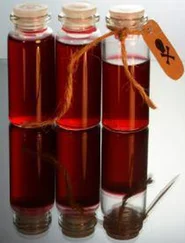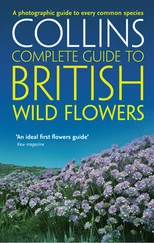There may be as many as 250,000 leaves on a mature oak tree, whilst a large spruce probably has 10 times as many, in the form of needles. The oak’s leaves will be shed at the end of the growing season, adding to the rich accumulation on the ground beneath it, whilst the spruce’s needles will be shed and replaced gradually, each individual needle remaining on the tree for about 4 years.
Trees normally produce flowers when they are several years old. Beech, for example, produces its first flowers at around 30 years old, repeating the process each spring for the next 200 years if it remains healthy. Some trees, such as apples or oaks, have years in which they produce a large crop of fruits or seeds, followed by other years with hardly any, whilst other species, such as some maples, produce a good seed crop year after year.
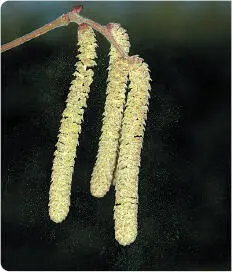
Even a slight breeze will liberate pollen from the male catkins of Hazel
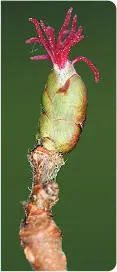
Carry it to female flowers.
Some trees and shrubs produce conspicuous flowers to attract pollinating insects, something that, in ornamental trees, we also find attractive. Honey Bees are particularly important pollinators, but numerous other insects visit the flowers for nectar and pollen. Many flowering trees have also long been prized by gardeners for their scent.
Many trees are pollinated by the wind. Their flowers are less conspicuous, often taking the form of catkins, which are pendulous and usually open before the leaves so that nothing impedes the free movement of the pollen grains. Wind-pollinated flowers normally have flowers of separate sexes, the males usually being larger and more abundant. Many wind-pollinated trees are such prolific producers of pollen that on warm breezy days in spring clouds of pollen can sometimes be seen blowing from the trees.
Conifer flowers are either male or female, and borne on the same or different trees. There are no petals, but some of the flowers are still quite colourful and decorative. Male flowers are short-lived, falling off after they have released clouds of pollen, but the female flowers, often covered with brightly coloured scales, remain on the tree after pollination and develop into cones containing the seeds. They rely on the wind for pollination and also for seed dispersal. A few close relatives of the conifers, such as the yews, produce fleshy fruits instead of cones.

Mature cones open and close in response to temperature and humidity, releasing seeds in hot, dry conditions.
The flowers of broadleaved trees and shrubs are usually hermaphrodite, containing both male and female parts, but there are a number of exceptions. Both sexes usually have petals in some form or other and they may also be scented. Small flowers are often grouped together in larger clusters to help attract pollinating insects. Some are wind-pollinated and open early in the year before the leaves, but insect-pollinated flowers usually open in spring and summer when more insects are active.
The fruits of trees and shrubs are much more varied than the cones of the conifers. They range from tiny papery seeds with wings, through nuts and berries, to large succulent fruits in a variety of shapes and colours. Edible fruits are designed to assist dispersal of the seeds by animals and many are delicious to the human palate.
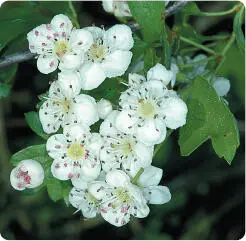
Hawthorn flowers are an attractive sight in spring and are irresistible to pollinating insects.
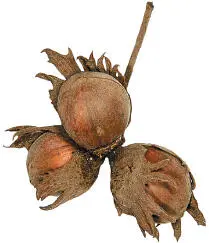
HAZEL – NUTS
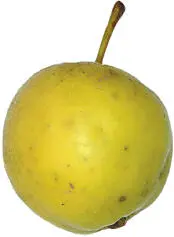
CRAB APPLE – FLESHY FRUIT

SYCAMORE – WINGED SEEDS
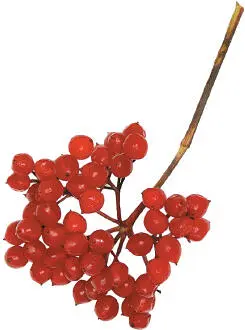
GUELDER-ROSE – BERRIES
The fruits of broadleaved trees and shrubs come in a range of shapes and size, including winged seeds, hard-cased nuts, luscious berries and juicy fruits.
Nobody could have any doubt that a mature Wellingtonia or an ancient, spreading Pedunculate Oak is a tree, but would a prostrate Juniper, or a Creeping Willow, also qualify, or are they merely shrubs? One feature common to both trees and shrubs is that their stems increase in thickness each year by the laying down of internal layers of woody tissue in the form of concentric rings. This secondary thickening builds up year by year to increase the diameter of the stem and gives a permanent record of the age of the tree or shrub.
Trees are generally considered to have a single main stem of 5m or more in height with a branching crown above this, whereas shrubs may have numerous stems arising at ground level and may not normally reach the height of a tree. Both trees and sizeable shrubs are covered in this book but the distinction is not always clear. Individuals of the same species may become trees or form shrubs, depending on the circumstances in which they are growing, or their management. Hazel, for example, forms a multi-stemmed shrub in response to coppicing, or cutting back to the rootstock; each time this is done, new shoots arise from the rootstock and the Hazel regenerates. If this cutting back does not take place, it can grow as a medium-sized tree on a single stem.
Trees do not belong to a single family of plants; many plant families are represented, and some, like the Fabaceae and Rosaceae, also include many herbaceous plants and shrubs as well as large trees.
The plant kingdom is divided into two main classes, the Gymnosperms and the Angiosperms. The most primitive of the two classes is the Gymnosperms, the name meaning ‘naked seeds’; the ovule is borne on a bract and not enclosed in a seedpod or case. This class includes the Maidenhair Tree, a very primitive tree, and all the conifers, or cone-bearing trees.
The name Angiosperm means ‘hidden seeds’ and refers to the way the seeds are contained inside an ovary, a structure that may later develop into a seedpod or fruit. This large class includes many well-known plant families, some of which are mostly made up of herbaceous plants, and some of which are mostly composed of trees. The Limes (Tiliaceae) and Elms (Ulmaceae), for example, are mostly trees, whilst trees feature in only one of many genera in the Foxglove family (Scrophulariaceae). All of our garden and wild flowers, bulbs, palms and the grasses and cereals are Angiosperms.
Читать дальше









